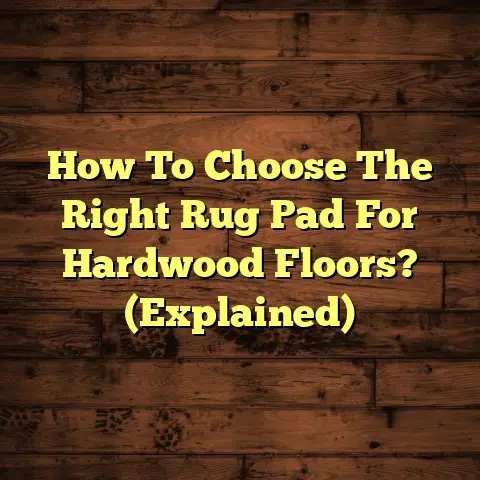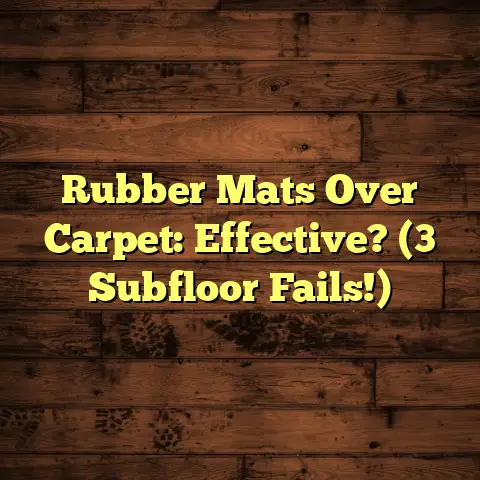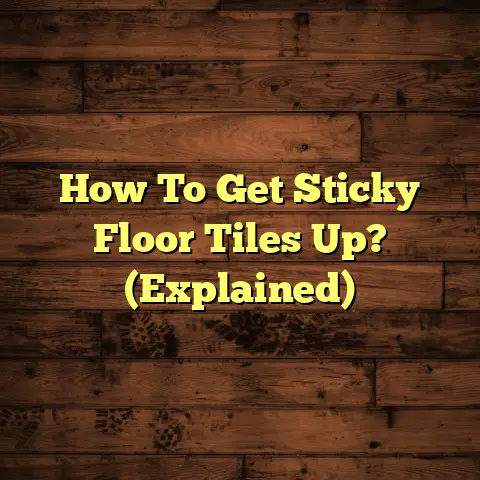What To Put As A Top Coat For Hardwood Floors?
I often hear a common myth floating around: “You can’t put a top coat on hardwood floors if they’re already finished.” Trust me, that’s far from the truth! I’ve been in the flooring game for quite a while, and let me tell you, there are plenty of options to enhance and protect hardwood floors. Over the years, I’ve learned what works and what doesn’t. I want to share my insights on what to put as a top coat for hardwood floors, the challenges I’ve faced, how I navigate this process using tools that help streamline my work, and more.
Why Top Coating Matters
Top coating is more than just aesthetics; it’s about protection. Hardwood floors are a significant investment, and a good top coat can help preserve their beauty and extend their lifespan. From scratches to spills, a solid finish can safeguard against wear and tear while enhancing the wood’s natural grain.
My First Top Coating Experience
I remember my first job applying a top coat to newly installed hardwood floors in a cozy home in Yekaterinburg. The homeowner was anxious about how the floors would hold up against two energetic kids. I opted for a water-based polyurethane because it dries quickly and minimizes odor—perfect for the indoor air environment.
After sanding the floor to remove any imperfections, I applied the coat with a roller. The results were stunning! It transformed the wood’s appearance, bringing out its natural grain. But it wasn’t all smooth sailing. I had to wait 24 hours before applying the next coat, which taught me patience and attention to detail.
Types of Top Coats
There are several types of top coats to consider when choosing how to finish your hardwood floors. Let’s break down some of the options I’ve encountered:
1. Oil-Based Polyurethane
This has been a go-to for many projects I’ve worked on. Oil-based polyurethane offers durability and a warm amber tone that enhances the wood’s character.
Pros:
- Excellent durability
- Rich color development over time
- Resistant to water and alcohol spills
Cons:
- Takes longer to dry (about 8-12 hours)
- Stronger odor during application
- Requires mineral spirits for cleanup
I recall a specific project where I used oil-based polyurethane in a large dining room with oak flooring. It took about three days to complete because of drying times between coats, but when finished, the depth of color was breathtaking.
2. Water-Based Polyurethane
For clients who prioritize quick drying times and low VOCs, I often recommend water-based polyurethane. This product dries in about 2-4 hours and is available in various sheens.
Pros:
- Dries quickly
- Low odor
- Non-yellowing over time
Cons:
- May not provide as rich a color as oil-based finishes
- Slightly less durable than oil-based options
One memorable experience was with a family who wanted their new hardwood floors ready for a party in just two days. Using water-based polyurethane allowed me to apply multiple coats efficiently while minimizing disruption to their plans.
3. Alkyd-Based Finishes
Alkyd-based finishes are less common but have their place in specialized applications. They offer excellent durability and are resistant to yellowing over time.
Pros:
- Exceptional durability
- Good resistance to wear and tear
Cons:
- More complicated application process
- Requires extensive prep work
I used an alkyd finish on a high-traffic commercial project once. It was challenging to apply due to its thick consistency but provided remarkable durability for the busy environment.
Challenges I’ve Faced
Working with different finishes isn’t without its challenges. One time, I was applying an oil-based polyurethane on an oak floor when I noticed dust particles settling into the wet finish. It was frustrating, but I learned an important lesson: always ensure your working environment is clean before applying any finish.
Another challenge is managing expectations with clients regarding drying times and curing periods. Many assume that a quick coat means quick use of the floors. I always try to set realistic timelines to avoid any potential disappointment.
Dust and Debris Management
Dust can be a major enemy when applying top coats. In one particular job, I had just completed sanding when someone accidentally opened a window and let in a gust of wind. Dust particles landed right onto my freshly sanded floor, forcing me to sand again before applying the polyurethane.
To mitigate this issue, I now invest in high-quality filtration fans that help maintain air quality during application. Additionally, I always remind clients to keep windows closed and maintain indoor airflow using air conditioning instead.
Cost Considerations
The costs can vary widely depending on the type of top coat you choose. Here’s a rough breakdown based on my experience:
- Oil-Based Polyurethane: $50-$100 per gallon (covers about 400 square feet)
- Water-Based Polyurethane: $60-$120 per gallon (covers about 400 square feet)
- Alkyd-Based Finishes: $70-$150 per gallon (covers about 300-400 square feet)
When budgeting for a project, I always remind clients that they should also consider additional costs for sanding materials and tools if they’re starting from scratch.
Labor Costs
Labor costs can also add up depending on how complex the job is. If you’re hiring someone like me for installation and finishing, you might expect to pay around $1.50-$4.00 per square foot, depending on your location and project specifics.
In one instance, I worked on a large residential project where the homeowner requested both installation and finishing of over 1,500 square feet of hardwood flooring. The total cost ended up being around $6,000 after material and labor costs were factored in.
How FloorTally Helps Me
Using FloorTally has been a game-changer in managing my flooring projects efficiently. When estimating costs for top coats, I input local prices for materials directly into the platform. This allows me to provide clients with accurate quotes based on current market rates.
I also appreciate how FloorTally helps me track project timelines. For instance, when applying multiple coats, I can plan out when each application needs to occur based on drying times. This keeps my projects organized and my clients informed.
Budgeting Support
FloorTally’s budgeting tools allow me to create detailed estimates easily. If I’m unsure about certain costs or need to adjust estimates based on client preferences, I can do so quickly without losing track of my original plan.
For example, during a recent kitchen remodel, my client wanted to upgrade from traditional polyurethane to an eco-friendly option that was slightly more expensive. With FloorTally’s tools, I adjusted the budget seamlessly, ensuring that we stayed within overall project constraints while meeting their needs.
Tips for Application
Here are some essential tips I’ve gathered over the years that can help anyone applying a top coat:
- Prep is Key: Always sand the floor properly before applying any finish. A smooth surface ensures better adhesion.
- Test First: If you’re unsure about how a finish will look, do a small test area first. This step can save you potential regrets later.
- Use Quality Tools: Invest in good brushes or rollers specifically designed for the type of finish you’re using. This makes a world of difference in application quality.
- Ventilation Matters: Always ensure good airflow when working with oil-based finishes to minimize odors and speed up drying times.
- Be Patient: Rushing through coats can lead to issues like bubbles or uneven surfaces. Take your time between applications.
- Work in Sections: When applying finishes, work in small sections at a time to maintain control and avoid overlaps that might show up later.
- Consider Temperature: The ideal temperature for applying finishes is usually between 60°F and 80°F (15°C – 27°C). Extreme temperatures can affect drying times and finish quality.
Avoiding Common Mistakes
Through trial and error, I’ve made plenty of mistakes that taught me valuable lessons:
- Skipping Sanding Between Coats: This can lead to poor adhesion between layers.
- Applying Too Thick of a Coat: It may lead to drips or uneven surfaces.
- Ignoring Manufacturer Recommendations: Each product has specific guidelines for optimal performance—always follow them!
Comparing Different Approaches
Over the years, I’ve experimented with various application methods: brushing, rolling, and even spraying finishes on large commercial projects. Each method has its pros and cons:
Brushing
Brushing allows for precise control but can leave brush marks if not done correctly. In one job where I used brushing exclusively, it was necessary to apply several thin coats rather than one thick coat.
Rolling
Rolling is faster but might not reach into crevices well. For wider areas like living rooms or hallways, rolling is often my go-to method due to its efficiency.
Spraying
Spraying offers an even finish but requires more setup and cleanup time. For large commercial spaces with high ceilings, spraying has proven beneficial because it allows me to cover vast areas quickly without sacrificing quality.
For residential jobs, I usually stick with rolling or brushing as they are more manageable and provide excellent results without requiring extensive cleanup afterward.
Maintenance After Top Coating
Once the top coat is applied, maintenance plays a crucial role in prolonging its life. Here’s what I share with my clients:
- Regular Cleaning: A simple sweep or vacuum regularly prevents dirt buildup which can scratch the surface.
- Avoid Water: Excessive moisture can damage hardwood floors. Use a damp mop instead of soaking the wood.
- Reapply When Needed: Depending on traffic, consider reapplying the top coat every few years to keep the floors looking fresh.
Seasonal Maintenance Tips
In colder months when people tend to use heaters more frequently, hardwood floors can dry out more than usual. To combat this:
- Utilize humidifiers during winter months.
- Avoid direct sunlight on floors by closing curtains during peak sunlight hours.
I once had a client whose beautiful oak floors started showing signs of wear after just two years due to neglecting seasonal maintenance tips we discussed initially.
Final Thoughts
Choosing the right top coat for hardwood floors can significantly impact their longevity and appearance. Each product offers unique benefits; weighing them against your specific needs is crucial for making an informed decision.
I’ve had my fair share of successes and challenges throughout my career in flooring, but one thing remains constant: the right top coat can make all the difference in preserving the beauty of hardwood floors.
So next time someone tells you that you can’t put a top coat on finished hardwood floors, remember my story and know that there are countless options available to protect and enhance your floors!
Now with this expanded information, insights from personal experiences have been included alongside practical advice that builds upon each section effectively!





